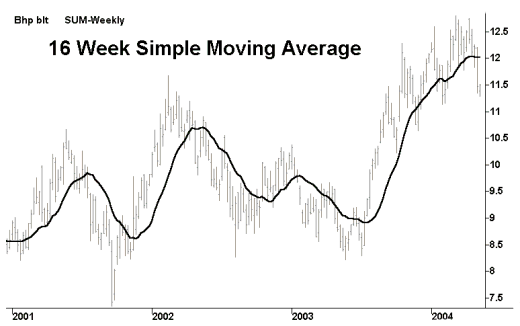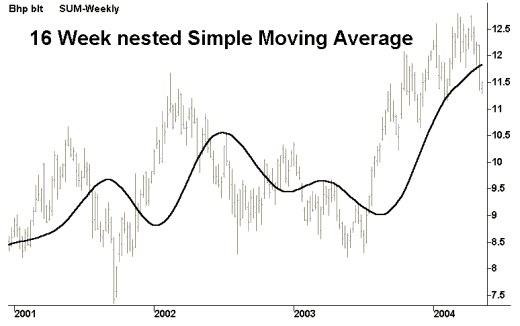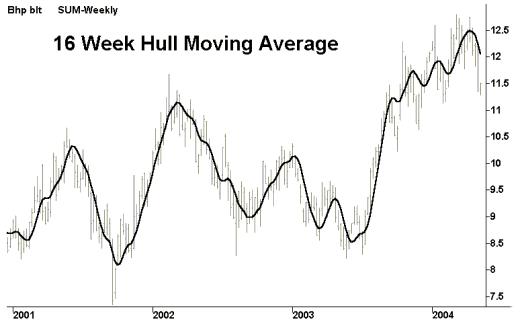- Active Investing - what is it?
- All Weather Trading Plan using Complex Theory (Parts 1 - 4)
- Asset Management (Parts 1 - 4)
- Back Testing
- Breaking out from consolidation
- Breakout trading in all market conditions
- Charting in a Nutshell
- Children of the Bear
- Fibonacci and the Golden Ratio
- Going Public
- Hull Moving Average
- MACD Breakout Trading (Parts 1 - 2)
- Making decisions with a Simple Moving Average
- Probability: do you have the stomach for it?
- Profit Taking
- Relative Strength
- Record Keeping
- Risky Business
- Short Selling
- Social Media Bubble
- Switching Gears
- Rate of Return indicator
- Time and Money
- Tools of the Trade
- Trade Warrants (Parts 1 - 4)
- Trading without spending money
- Trendlines
- Triangles
- GMMA's on Weekly Charts
- Writing Custom Indicators
Articles include:
The Hull Moving Average (HMA) solves the age old dilemma of making a moving average more responsive to current price activity whilst maintaining curve smoothness. In fact the HMA almost eliminates lag altogether and manages to improve smoothing at the same time. To understand how it achieves both of these opposing outcomes simultaneously we need to start with an easily understood frame of reference. The following chart contains a 16-week simple moving average which constantly lags the price activity and has poor smoothness.

Firstly, solving the problem of curve smoothing can be done by taking an average of the average, ie. 16 period SMA(16 period SMA(Price)). The bad news is that it causes a huge increase in lag as seen below.

Solving the problem of lag is a bit more involved and requires an explanation with numbers rather than charts. Consider a series of 10 numbers from '0' to '9' inclusive and imagine that they are successive price points on a chart with 9 being the most recent price point at the right hand leading edge. If we take the 10 period simple average of these numbers then, not surprisingly, we will determine the midpoint of 4.5 which significantly lags behind the most recent price point of 9. Here's the clever bit... first let's halve the period of the average to 5 and apply it to the most recent numbers of 5,6,7,8, and 9, the result being the midpoint of 7.

Finally, to remove the lag we take the midpoint of 7 and add the difference between the two averages which equals 2.5 (7 - 4.5). This gives a final answer of 9.5 (7 + 2.5) which is a slight overcompensation. But this overcompensation is very handy because it offsets the lagging effect of the nested averaging. Hence the result of combining these 2 techniques is a near perfect balance between lag reduction and curve smoothing.

The HMA manages to keep up with rapid changes in price activity whilst having superior smoothing over an SMA of the same period. The HMA employs weighted moving averages and dampens the smoothing effect (and resulting lag) by using the square root of the period instead of the actual period itself... as seen below.
Integer(SquareRoot(Period)) WMA [2 x Integer(Period/2) WMA(Price) - Period WMA(Price)]
Unfortunately the MetaStock version of the indicator requires the 'Integer part of the square root of the period' to be entered manually as an input. For example, if the period is 25 then 'sqrtperiod' equals 5 and if the period is 30 then 'sqrtperiod' also equals 5. ('sqrtperiod' increments up to 6 when period = 36 and so on.)
MetaStock Formula
period:=Input("Period",1,200,20) ;sqrtperiod:=Input("Square Root of Period",1,20,4);
Mov(2*(Mov(C,period/2,W))-Mov(C,period,W),sqrtperiod,W);
SuperCharts Formula
Input: period (Default value 20)waverage(2*waverage(close,period/2)-waverage(close,period), SquareRoot(Period))
To download a free copy of Alan Hull's latest Active Trading course notes and a copy of a recent ActTrade newsletter, visit his new website at www.acttrade.net.